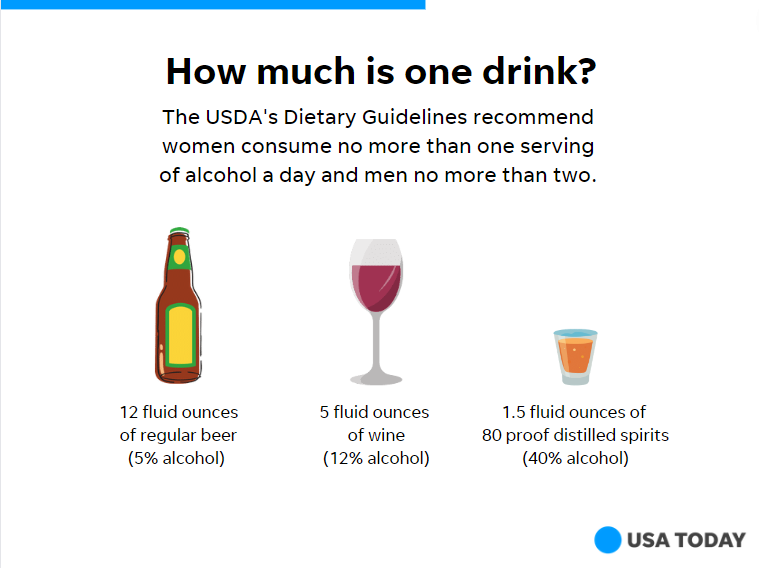The argument for making alcohol more expensive: It could save lives, study suggests.
In 2018, the Scottish government made drinks more expensive if it contained more alcohol.
It was an effort to reduce drinking in Scotland, which has the highest rate of death due to alcohol consumption in the United Kingdom.
Now in a study published this week, Scottish public health officials reported its minimum unit pricing policy was associated with a 13% reduction in deaths from alcohol consumption since it was implemented.
That translates to about 150 deaths per year, according to the report published Monday in The Lancet.
Researchers discovered the reduction in deaths was mainly due to long-term conditions, including a 11.7% decrease in deaths from alcoholic liver disease and 23% decrease from alcohol dependence syndrome.
The most significant impact was among people who lived in socio-economically deprived areas, where death rates are "more than five times higher compared to those living in the least deprived areas,” said Grant Wyper, public health intelligence adviser at Public Health Scotland.
Is any amount of alcohol safe? It depends on your taste for risk.
Alcohol use disorder: What to know and how to get treatment
Could this be a policy implemented in the Untied States? Here's what we know.
What is minimum unit pricing?
A minimum unit price for alcohol sets a floor price per unit of alcohol, according to the Scottish government, which means a drink will be more expensive if it contains more alcohol.
The minimum unit pricing in Scotland was set at 50 pence, or about 70 cents, per 8 grams of alcohol. One standard drink in the U.S. contains about 14 grams of alcohol. There is no national minimum unit pricing in the United States, though some states do have their own policies.

Unlike other alcohol policies, minimum unit pricing targets cheap alcohol typically consumed by heavy drinkers or young people.
“People who buy a lot every day tend to look for the best bargains,” said Tim Stockwell, former director of the Canadian Institute for Substance Use Research at the University of Victoria.
“Cheap alcohol is sought out by vulnerable people, young drinkers, heavy drinkers, people with alcohol dependence.”
Why the study is important
Previous studies have shown how minimum unit pricing on alcohol has impacted sales and consumption, experts say, but few have shown how it directly impacts health outcomes, like death.
“Deaths from alcohol is the final arbiter,” Stockwell said. “It’s the most exact measure of the effectiveness of the policy compared to all the other studies indicating benefits.”
The study shows how minimum unit pricing impacted Scotland’s most vulnerable population, he said, something opponents of the policy have long debated.
“Any argument about whether it’s affecting heavy drinkers cannot be sustained,” Stockwell said. “The biggest effect was in socioeconomic regions of Scotland with the lowest incomes, so it’s a strategy that reduces health inequities.”
What does this mean for US drinkers?
Few states, like Connecticut and Oregon, have implemented a version of minimum unit pricing for alcohol, Stockwell said, and it may be a while before more states catch on.
“It takes decades for policy to follow research,” he said. “Alcohol producers want to make a profit, retailers want a profit, and consumers want a bargain.”
In a 2022 report, the World Health Organization outlined the benefits of minimum unit pricing, recommending pricing and taxation policies on alcohol. Some countries like Canada, Australia, and Ireland have joined Scotland in instituting such policies.

As more data shows the benefits of minimum unit pricing and how it reduces harm in vulnerable populations, experts hope that more countries will follow suit. Along with such policies, leaders must also work to address systemic issues that make this population particularly vulnerable to alcohol-related harms and diseases.
“It is also important to ensure that in parallel with such research and policy change that we are also acknowledging, researching, and advocating for policies that address the inequality that causes so much health harms in the first place,” said Dr. Sarah Callinan and Dr. Amy Pennay, researchers at the Centre for Alcohol Policy Research at La Trobe University in Australia, who are unaffiliated with the study.
If your or someone you know is struggling with substance use disorders, you can call the Substance Abuse and Mental Health Services Administration National Helpline at 1-800-662-4357. The service is free, confidential and available in English and Spanish.
Follow Adrianna Rodriguez on Twitter: @AdriannaUSAT.
Health and patient safety coverage at USA TODAY is made possible in part by a grant from the Masimo Foundation for Ethics, Innovation and Competition in Healthcare. The Masimo Foundation does not provide editorial input.
This article originally appeared on USA TODAY: Alcohol cost: More expensive booze could save lives, study suggests

 Yahoo Movies
Yahoo Movies 
